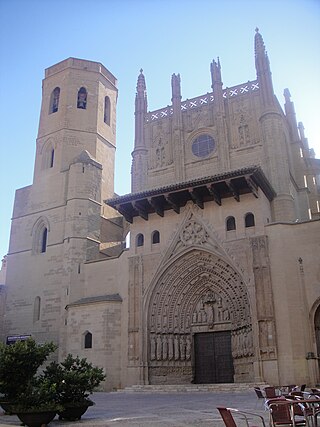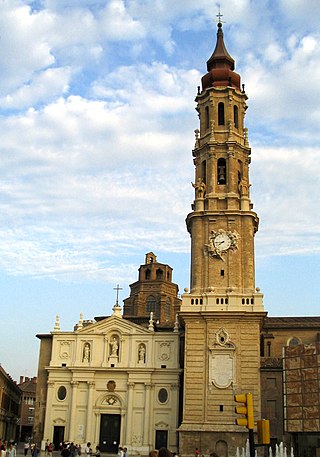
Huesca is a city in north-eastern Spain, within the autonomous community of Aragon. It was the capital of the Kingdom of Aragon between 1096 and 1118. It is also the capital of the Spanish province of the same name and of the comarca of Hoya de Huesca. In 2009, it had a population of 52,059, almost a quarter of the total population of the province. The city is one of the smallest provincial capitals in Spain.

Diego Columbus was a navigator and explorer under the Kings of Castile and Aragón. He served as the 2nd Admiral of the Indies, 2nd Viceroy of the Indies and 4th Governor of the Indies as a vassal to the Kings of Castile and Aragón. He was the eldest son of Christopher Columbus and his wife Filipa Moniz Perestrelo.

The Mexican state of Nuevo León has been governed by more than a hundred individuals in its history, who have had various titles and degrees of responsibility depending on the prevailing political regime of the time.

The Archdiocese of San Juan de Puerto Rico is a Latin Church ecclesiastical territory or diocese of the Catholic Church– comprising the northeast portion of the island of Puerto Rico. Its jurisdiction includes the municipalities of Dorado, Toa Baja, Cataño, Toa Alta, Bayamón, Guaynabo, San Juan, Trujillo Alto, and Carolina.
Diego de Montemayor was a Spanish conquistador, explorer, officer, and the governor of Nuevo Reino de León.

The Diocese of Huesca is a Latin Church ecclesiastical territory or diocese of the Catholic Church located in north-eastern Spain, in the province of Huesca, part of the autonomous community of Aragón. The Diocese of Huesca is a suffragan diocese in the ecclesiastical province of the metropolitan Archdiocese of Zaragoza.

The Archdiocese of Saragossa is a Latin diocese of the Catholic Church located in north-eastern Spain, in the province of Zaragoza, part of the autonomous community of Aragón. The archdiocese heads the ecclesiastical province of Saragossa, having metropolitan authority over the suffragan dioceses of Barbastro-Monzón, Huesca, Tarazona, and Teruel and Albarracín.
Sebastián Ramírez de Fuenleal was bishop of Santo Domingo and president of the Real Audiencia of Santo Domingo from 1528 to 1531. He was also president of the second Real Audiencia of Mexico from January 10, 1531, to April 16, 1535. Later he was a member of the Council of the Indies.

Damián Forment was an Aragonese Spanish architect and sculptor, considered the most important Spanish sculptor of the 16th century.

The Captaincy General of Santo Domingo was the first Capitancy in the New World, established by Spain in 1492 on the island of Hispaniola. The Capitancy, under the jurisdiction of the Real Audiencia of Santo Domingo, was granted administrative powers over the Spanish possessions in the Caribbean and most of its mainland coasts, making Santo Domingo the principal political entity of the early colonial period.

The mayor of Valenzuela, a highly urbanized city in northern Metro Manila, Philippines, is the official head and chief executive of Valenzuela. He leads on enforcing city ordinances and improving public services. The mayor has a term of office of three years, but has a maximum electoral tenure of three consecutive terms. Inaugural holder of the office was Pío Valenzuela (1869–1956), served from 1899 to 1901, whom the city received its name.

Francisco V Fernández de la Cueva y Fernández de la Cueva, was the 10th Duke of Alburquerque, a Grandee of Spain, a Knight of the Order of the Golden Fleece from 1707, and Viceroy of New Spain from 27 November 1702 to 14 January 1711. He was viceroy during the War of Spanish Succession and his tenure as Viceroy of New Spain is commemorated in the namesake of Albuquerque, New Mexico.

Mariana Fernández de Córdoba y Ayala, also known as Mariana de Ayala Córdoba y Toledo, was the fourth Lady of Casarrubios del Monte in the province of Toledo. She was the daughter of Diego Fernández de Córdoba y Carrillo, first Lord of Baena, and Inés Ayala y Toledo, third Lady of Casarrubios del Monte.

Pedro Fernández de Córdoba y Pacheco, first Marquess of Priego, was a Castilian nobleman. He became one of the most powerful men in Andalusia, but after the death of Queen Isabella I of Castile (1451–1504), he supported her daughter Joanna of Castile (1479–1555) against King Ferdinand II of Aragon (1452–1516), who was regent of Castile. After serious disturbances in Córdoba in 1508 he was forced to throw himself on the king's mercy, and was arrested and exiled. Later he was pardoned and allowed to return.













